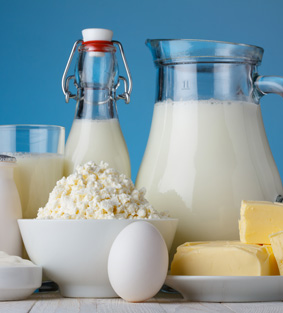
Nutrition and HD
Everyone can benefit from good nutrition and proper eating habits. For people with HD, good nutrition has been proven to be an important part of maintaining health and maximum functional ability. The purpose of this guide is to combine current dietary guidance for all people — such as reduction of calories, avoidance of trans fats, increased consumption of fruits, vegetables, and whole grains — with information about the special issues that affect nutrition in persons with HD and strategies to address these issues.
Research has shown that people with Huntington’s Disease often have a lower than average body weight for height, and may have higher than average calorie needs. This may be due to chorea, metabolic changes, or some other factor yet undiscovered. There is also some evidence that maintaining a body weight slightly above “desirable” weight will facilitate control of the disease. Therefore, people with HD should be encouraged to eat and every effort should be made to make eating enjoyable.
Many symptoms of HD can interfere with eating: reduced voluntary motor control, involuntary movements, problems with chewing and choking, as well as changes to cognition that may cause the individual to become distracted and overwhelmed by mealtime activity. Overcoming these challenges is an important part of maintaining good nutrition for the person with HD. As the disease progresses and other activities become limited, food and eating will take on even greater importance. The introduction of special utensils, dishes and modified seating, will help the person with HD continue to feed themselves as long as possible.
When it is no longer possible for the person with HD to meet his or her nutritional needs with an oral diet, enteral feedings (tube feeding) may be considered. Tube feedings may be given as a supplement to an oral diet, to provide extra fluids in case of swallowing difficulty, or as a sole means of nutritional support.
Making Nutrition Part of Your Game Plan
A presentation on the importance of nutrition in HD by Advanced Level Clinical Dietitian, Kristin A.R. Gustashaw, MS, RDN, CSG, LDN at the 2018 HDSA National Convention in Los Angeles.
Helpful Kitchen Tools
Having the right equipment can make preparing and serving meals for the person with HD much easier.
- Blender and/or Food Processor: A blender and/or food processor can be very helpful in preparing shakes, soups and sauces, and for pureeing favorite foods when a very soft consistency is needed. It is helpful to find one with multiple containers to allow for preparation of several foods quickly.
- Juicer: A juicer can be useful for a person with dental problems, who cannot chew fruits and vegetables as well. If swallowing is also a problem, try adding thickening powder or mix the juice into a thick shake or soup for a nutritional boost.
- Cappuccino Maker: A cappuccino maker may seem like a luxury, but switching from regular coffee to cappuccino made with whole milk and added cream (or vanilla ice cream!) can add some needed calories.
- Pastry Cutter and/or Potato Masher: A pastry cutter or potato masher can serve many purposes in mixing and mashing foods and are helpful for adding “extras” like butter or sour cream to a dish.
- Soup Plates or Pasta Dishes: Dishes with extended sides, also called “soup plates” or “pasta dishes” can help make clean up easier.
- Sports Cups: Sports cups with a cover and straw attached can be helpful in preventing spills.
- Large-Handled Spoons & Forks: Spoons and forks with larger handles can make picking up food easier. Rubber sleeves to slip onto the handles of your current tableware are also available
- Heated Baby Dish: A heated baby dish can be used as a warming tray to keep food warm throughout a meal for a slow eater.
Tips to Maintain Food Intake
1. Eat smaller, more frequent meals (i.e.: 6 instead of 3 times a day).
2. Eat favorite foods in a relaxed, pleasant atmosphere.
3. Keep snacks available at all times, such as candy, cheese, cookies, ice cream, sandwiches, or mini-pizzas.
4. Use other cues to remind yourself to eat, such as a clock with a timer, a beeping wristwatch, or the commercial breaks on television.
5. Avoid drinking liquids with meals because you will fill up too quickly and not have enough room for the food.
6. If you drink a supplement or shake, drink it between meals.
7. Avoid drinking beverages without calories (i.e.: diet soda, seltzer).
8. If you drink coffee or tea, add sugar and whole milk or cream for extra calories. Or, try a cafe latte or chai tea.

How to Increase Calories
- Use cream, whole milk, evaporated milk, or condensed milk instead of low fat or skim milk.
- Add cheese, sour cream, butter, margarine, or oil to vegetables.
- Add avocado to salads or top with creamy-style dressings.
- Add cream or butter and sugar to cereal.
- Scoop ice cream over fruit, cake, pie, or waffles.
- Add extra mayonnaise to tuna, egg, or chicken salad.
- Try cream cheese or peanut butter on crackers, bagels,fruit, or carrot sticks.
- Add coconut cream to shakes or main dishes for extra calories and a tropical taste.
- Sauces and gravies add calories to meat and potatoes.
At-Risk Early Stage HD Nutrition Isssues
Brain Healthy Diet
Based on research literature for the general population, and other common neurological conditions, such as dementia, there are some dietary factors considered to be “brain healthy”.
Three of the most important dietary factors in a brain-healthy diet are vitamin B-12 anti-oxidants and anti-inflammatory agents. There are many foods that provide these substances, so you can take your pick of these foods to incorporate into your diet. Try to include at least one at every meal.

Vitamin B12
Vitamin B12 is found in animal foods (meat, dairy, eggs, poultry, etc.). B12 keeps the body’s nerve and blood cells healthy and helps make DNA. Studies have shown that prolonged deficiency of this vitamin may have neurological effects on the brain and can cause nerve damage, although these effects are not specific to HD. Most people in the US get enough B12 if they include animal foods in their diet.

Antioxidants
Antioxidants protect your cells from free radicals (“bad” cells) in the body. COLOR is important when choosing foods with antioxidant properties – foods with deep, rich color tend to be higher in antioxidants. Choose a variety of fruits and vegetables to get the most benefit. These nutrients are good for everyone, not just someone with HD. More research is required to determine whether there is a specific increase of antioxidants needed for people with HD.

Essential Fatty Acids — Omega 3 & Healthy Fats
Omega 3 fatty acids are helpful in reducing inflammation throughout the body. They also can reduce triglycerides (and have a blood thinning effect so check with your doctor before taking a supplement). Other healthy fats include olive oil, nut butters, and avocados.

Early/Mid Stage HD Nutrition Isssues
Speech & Language Therapy
Early referral to speech and language therapy is important. In early-stage HD, a person may have no issues swallowing, but speech and language therapists may still have a role in evaluating an individual’s baseline state, and providing information for the future.
HD affects individuals differently, so regular assessment is required to help an individual maintain function. There is significant overlap in feeding and swallowing issues in the mid and late stages. As the disease progresses the challenge of maintaining adequate nutrition and hydration becomes greater.
Click here to find a speech therapist in your area.
Late Stage HD Nutrition Isssues
Tube Feeding
Feeding tubes are usually recommended when a person is no longer able to take in adequate amounts of nutrients by mouth to maintain their weight at a healthy point. Ideally this should be decided while the person is still able to consider the pros and cons for him/herself, and well in advance of the need for tube feeding. Often, having liquids and formula feedings via tube the pressure of meeting an individual’s calorie needs.
There are several ways tube feeding is administered:
- Continuous: Running twenty four hours a day, every day
- Intermittent / Cycled: Running only part of the day (cycled overnight or running for 12 hours for example)
- Bolus: Bolus is given either via syringe or gravity (drip without a pump) — at meal times typically
- Supplemental: This could be bolus or intermittent — this might be given in addition to eating if unable to eat adequate calories (but it could be done by any of the above methods)
Further Reading
HDSA Resources
HDSA Family Guide Series: Nutrition and HD
Managing Swallowing Difficulties Associated with HD
Caregiver’s Corner Webinar: HD & Nutrition
In the Thick of It: What you Need to Know about Thickened Liquids, by Ann Gaba, We Are HDSA, June 2013
We Are HDSA Nutrition & HD Issue, February 2012
Nutrition intervention in HD by Susan Sandler
Strategies for Speaking and Eating with HD, by Jeanne E. Thomson, The Marker, Spring 2001
A Caregiver’s Handbook for Advanced Stage HD
Other Resources
Guideline for Oral Healthcare for individuals with Huntington’s disease
Selected High Calorie Recipes from the HDSA Center of Excellence at Columbia University
Please Note: All of the above articles, presentations and resources are for informational purposes only. HDSA encourages all to consult with their primary care provider, neurologist or other healthcare provider about any advice, exercise, medication, treatment, nutritional supplement or regimen that may have been mentioned anywhere on this site.
We welcome your feedback. Please contact Jennifer Simpson, LCSW, HDSA’s Senior Manager of Advocacy & Youth Programs at jsimpson@hdsa.org with your comments or questions.

